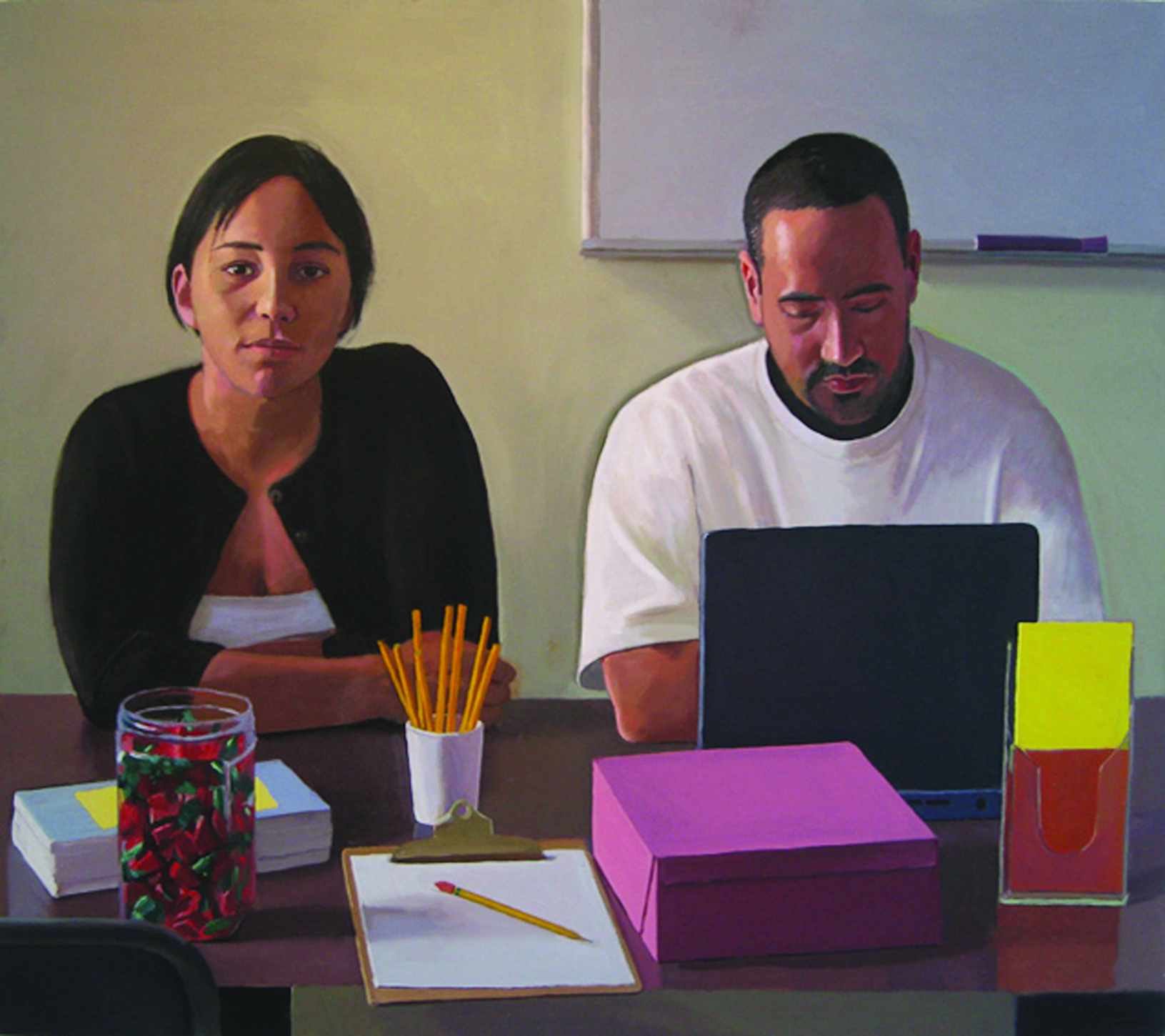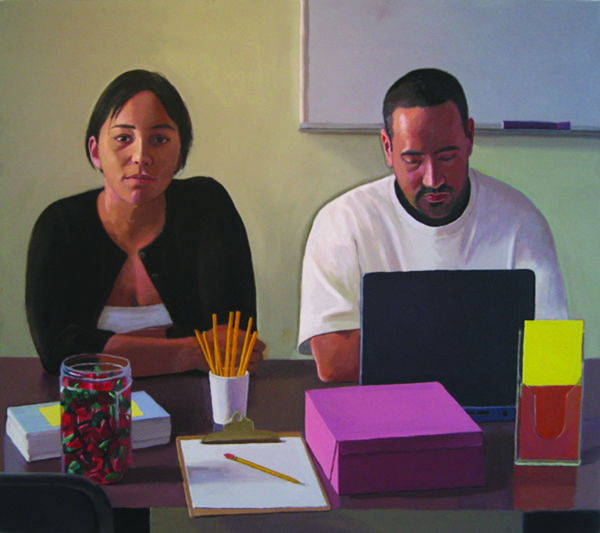
30 Jul Telluride Gallery of Fine Art: “Objective” for Art Walk +
Telluride Arts’ First Thursday Art Walk is a festive celebration of the art scene in downtown Telluride for art lovers, community, and friends. Participating venues host receptions from 5 –8 p.m. to introduce new exhibits.
For other August Art Walk shows, go here.
The big show opening with this month’s Art Walk, Thursday, August 3, is “Objective” at the Telluride Gallery of Fine Art, curated by the artist featured at the gallery in July, James Hayward.
“This group show consists of the work of 12 painters from around the country, mostly Los Angeles-based. The title, ‘Objective,’ encompasses landscape, figurative, allegory and other representational, often abstracted works. The show will have a counterpoint in December, “Non-Objective,” which will feature 13 painters from around the US and their abstract and minimal works,” explained Ashley Hayward, co-owner, Telluride Gallery of Fine Art.
In the 1800s. Albert Bierstadt and Frederic Church went way over the top in their monumental depictions of cathedral-like cliffs and the Golden Glow that enveloped a scene. Small wonder: in the 19th-century being a landscape painter had political and moral overtones:
“If the presiding metaphor of the landscape experience was that of God as supreme artist, it need only be a short step to the idea that artists were seers or priests,” Robert Hughes, American Visions.
Diane Best is an heir to that tradition, a high priestess in service to the open wilderness and deserts of Southern California. She paints highly stylized, reverential landscapes:

Tetons, acrylic, Diane Best
“…It never ceases to amaze me that, as heavily populated and built up as Southern California is, that there still remain these vast areas of open wilderness and desert where you can drive miles and miles of dirt roads and see no one for days, if you choose not to. The importance of keeping this kind of experience (of being alone, in a meditative state, in unpopulated oceans of desert, actually being able to see and ride ‘off into the distance’) protected and available to the public, is an overriding motivation for me in my work – hoping to convey a sense of this to those not living in the middle of it.”
The point of fine art is to engage us, slow us down in our thinking, in our looking, and keep us fully engaged. Case in point, the work of artist Dan McCleary, who appears to be drawing us into the silent storytelling of his frozen theatre:

Protection, oil on canvas, Dan McCleary
“I will have the model come and pose for drawings and sometimes a photograph… The models return many times and pose in sets I build in the studio… It can take up to nine months to finishing a painting. I want to keep a prudent distance from the model. The people I paint are always people I have respect for… Once I figure out the subject, you view the painting as a complex puzzle of colors, shapes….”
Diane Best and Dan McCleary are in town on Thursday, August 3. They are part of a group show entitled “Objective” up through August at the Telluride Gallery of Fine Art. The opening coincides with Telluride Arts’ August Art Walk. The show was curated by celebrated artist, art historian and teacher James Hayward, whose muscular mandalas were featured at the Gallery in July.
The sheer weigh of Hayward’s monochromatic impasto crests appear to defy gravity in his resolutely abstract improvisations. How does that energy remained contained in a vertical picture plane?
And yet Hayward, a non-objective artist if there ever was one, put together a show of objective art.
Ironic?
Puzzling?
Only if you believe that abstract and representational painting are – err – oil and water.
To clarify, let’s start with some basic definitions.
Objective art is artwork that depicts easily recognizable subject matter. It is also known as representational or figurative art.
Objective abstract art is an art form which depicts concrete physical objects in simplified, or distorted, or exaggerated form.
Non-objective (non-representational) abstract art reshapes the natural world for expressive purposes and derives from, but does not imitate a recognizable physical subject.
And yes, there is a Modernist insistence on a separation between objective and non-objective art, abstraction and representation, but the idea robs painting of its true essence. Pictorial communication in the form of signs, symbols, images and colors on a two-dimensional flat surfaces is an old, rich human invention that started out on rocks and ceramics and remains one of the most efficient, elegant, and intimate means of self-expression and engagement.
Hayward explains it all this way:
“…While the focus of my own efforts reside primarily in the realm of abstraction, I collect and support all forms of painting… I personally know, admire, respect and collect most of the painters I have included in this show. I chose the title, Objective Painting, as it seemed sufficiently open to include figurative, landscape, allegorical, portrait, nature, fantasy and the surreal…”
In addition to exposing Best and McCleary and the other painters in this sweeping survey of art, Hayward believes the show will do what good art of any kind (objective or non-objective) should be able to do: capture and hold the viewers attention through the intrinsic energy of the work, a collective adventure.
“Objective” also includes images by:
Tom Allen, who thinks of his surrealistic portraits – “more suggestions than depictions” – of driftwood as statues or ghosts.
Gregory Botts, whose objective abstract art is about transformation: “a tree becomes a figure” and also a unity of “deep space” (what’s inside the artist and drives his will to form) and “surface space,” which, in the artist’s view, is the whole idea of painting.

Aspens Night, oil on canvas, Gregory Botts
Brian Fahlstrom’s expressionistic, animated landscapes come to him in a dream. While his work is grounded in tradition, the artist sees his images as “alive in the present.”
Frank Gaard work came out of the formalist tradition of Hans Hoffman and was inspired by Cezanne. However, the artist introduces caricature into the mix for fun – and a bit of shock value: “You have to seize the person by the collar and tell them to feel good, or be happy or enjoy yourself. The pictures have that quality.”

(On the left), Susan in the Rain, acrylic on paper, Frank Gaard
Steve Galloway claims he makes art as a way to travel inside. The work itself, decidedly surreal, is the result of that journey, which captures the plausible, the improbable and the impossible.

Trance Dance, oil on canvas, Steve Galloway
In Amy-Claire Huestis’ soulful, expressionistic paintings, she depicts us humans as a surreal and magical presence in nature.

Rainbow Woman, oil on linen, Suzanne Huestis
Ed Johnson’s paintings are the result of a winter hiking in the San Gabriel Mountains, where he left his mother’s ashes on the peaks of the Lower Range, work he claims was inspired by both the beauty and banality of the images he shot en route.
Julia Lackner’s spectral phase images, abstract and stylized but recognizable as landscapes, reflect the artist’s interests in how natural phenomena – night, sky, clouds and fog – obscure vision: “Painting atmosphere and the palpability of air has always been at the root of my paintings.”

Santa Barbara Pier, oil on canvas, Julika Lackner.
Rae Lewis grew up in a sparsely populated region of Southern Utah. Her father was a sheep rancher. Their summer range at 9,000-feet overlooked the dramatic canyons of what is now Zion National Park. As a child, she explored all that colorful beauty on foots; as an adult, her recorded memories of that place, its geology and geography, evolved into the much more complex, phantasmagorical world of abstraction.
Max Maslansky’s paintings are based on vintage porn – though he often departs radically from the source: “… I want the viewer to have a non guilt-ridden sort of pleasure that comes with guilty feelings.”

Artist’s Studio, acrylic on found bedsheet, Max Maslansky


Pingback: Telluride Arts & Telluride Jazz Fest: August Art Walk, Jazz Edition | Telluride Inside... and Out
Posted at 20:36h, 31 July[…] Telluride Gallery of Fine Art: “Objective” for Art Walk + – July 30, 2017 […]